Causes and Control Measures of Early Concrete Cracks
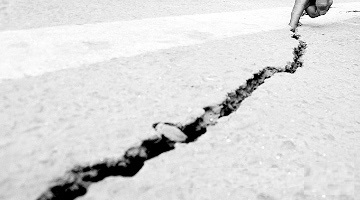
1. About concrete cracks
Crack is the most common defect in concrete engineering, which is divided into macro crack and micro crack. The width of the crack that is not visible to the naked eye is generally referred to as the macroscopic crack width of 0.03mm-0.05mm. Therefore, the visible crack is called macro crack, and the invisible crack with width less than 0.05mm is called micro crack.
The micro cracks of concrete are generally inherent in concrete. The reason is that concrete is composed of cement paste, sand and stone aggregate after hydration and hardening of cement paste. Their physical and mechanical properties are inconsistent, which is a heterogeneous composition. The dry shrinkage value of the hardened cement paste is large, while the aggregate in the concrete limits the free shrinkage of the cement paste. This constraint causes micro cracks on the bonding surface between the aggregate and the cement stone in the concrete from the beginning of hardening. In other words, even if there is no external load (whether the type of external load is self weight, load, internal stress caused by volume change, etc.) or even if the volume change of concrete is not constrained by the outside, there are micro cracks in the concrete. This kind of micro crack is stable under little external force or deformation.
Concrete is a kind of building material whose compressive capacity is much greater than the tensile capacity (the tensile strength is 1 / 8-1 / 10 of the compressive strength). When large tensile stress is generated in the concrete due to load, or constrained due to the change of concrete volume, large tensile stress is generated in the concrete, or when the volume changes due to rapid water loss in the early stage, if the tensile capacity at this time cannot resist the generated tensile stress, The concrete is cracked to relieve stress. Cracking starts from the bonding surface with micro cracks. When the external force or deformation is large, the micro cracks on these bonding surfaces will develop and expand through the hardened cement stone and gradually develop into visible macro cracks.
See picture-1 below: early plastic shrinkage cracks in concrete.
2. Bleeding and settlement of concrete
The phenomenon that solid particles sink, water rises and water separates out on the surface from the pouring of concrete mixture to the beginning of condensation is called bleeding. After bleeding, the loss of water will cause settlement shrinkage of concrete. If measures are not taken to eliminate the settlement shrinkage, settlement shrinkage cracks will occur. Bleeding is usually caused by freshly mixed water, and a little bleeding is normal for high-quality concrete. It leads to a small amount of balanced exudate on the whole surface. For the interior of the concrete, a small amount of water exudate will reduce the water cement ratio of the internal concrete and improve the strength of the concrete. On the other hand, after bleeding, the upper layer of concrete becomes water rich cement slurry, and there is too high W / C in this area. It leads to insufficient concrete surface strength, porosity and lack of durability. Therefore, the secondary plastering after the concrete bleeding will destroy the rich water layer and make the concrete surface tend to be consistent with the water cement ratio again, so as to reduce the possibility of the above quality hidden dangers.
At the same time, the bleeding layer accumulated on the concrete surface after bleeding plays a good role in the curing of concrete, which is like a layer of "water quilt" covering the surface of concrete, which greatly reduces the plastic shrinkage cracks caused by water loss. However, when the external temperature, humidity and wind speed conditions are bad, and the evaporation rate of seepage water is faster than that of bleeding, plastic shrinkage cracks are easy to appear. At this time, when the seeping water can not form a good curing environment, it is necessary to artificially create this good environment, and it is necessary to supplement water to form a higher humidity.
The plastic shrinkage crack on the surface has occurred before the final setting of the concrete. Therefore, the time of replenishing water for wet curing must be advanced. When the water appears on the concrete surface after bleeding and the luster disappears (generally one to three hours after concrete pouring), technical measures including secondary vibration plastering and watering curing shall be taken immediately, It should be noted that the covering must be wet or watered immediately after covering to make the covering completely wet.
High efficiency water reducing agent is used for ready mixed concrete. The water consumption in each square of concrete is less than that of on-site mixing without water reducing agent, and there are more cementitious materials and less bleeding than that of conventional pouring methods. These two reasons will accelerate the formation of early plastic cracks, which requires special attention. When pumping concrete is adopted, the construction speed is fast and the content poured into the formwork at one time is large. Therefore, sufficient personnel shall be arranged to take technical measures for the concrete at risk in time.
Plastic shrinkage cracks often appear on the sides of floors, floor slabs, and girders
Plastic settlement cracks often appear in: plate beam joint, plate wall joint, beam wall joint, and the foundation part with reinforcement on the surface. Settlement cracks are easy to appear in thicker base plate, deeper beam and shear wall.
3. Classification and causes of early concrete cracks
Early concrete cracks generally appear when the concrete is still in plastic state before the initial setting of the concrete. Generally, the construction personnel leave the construction site after the concrete pouring, and they will be found when watering begins the next morning. In hot and dry seasons, sometimes on the beam and slab, the concrete poured in the formwork will appear one or two hours later, and the cracks will be clearly visible even before the secondary plastering and polishing. It is generally called plastic crack, which is divided into plastic shrinkage joint and plastic settlement joint. The cracking mechanism of this kind of crack is concise and can be avoided or eliminated by corresponding measures.
Both plastic shrinkage cracks and plastic settlement cracks occur in the plastic stage of concrete, and the main reason is water evaporation. In the first few hours after concrete pouring, the concrete is still in the plastic stage. Under dry or hot climate conditions, when the evaporation rate exceeds the bleeding rate to reach the surface rate, the concrete surface loses water, and the original volume of water loses with evaporation, resulting in concrete volume shrinkage. When the concrete is constrained by reinforcement, it can not resist the tensile stress caused by shrinkage, resulting in cracks on the concrete surface, if evaporation continues without water supplement (without effective curing), the crack will gradually extend to the interior of the concrete with water loss until the whole section passes through. When the concrete is in a plastic state, the water evaporates rapidly from the concrete surface. At the same time, due to the bleeding of the concrete, the water also secretes from the interior of the concrete to the surface. The water evaporation and bleeding water rise on the concrete surface, resulting in drying shrinkage (volume shrinkage due to water loss) and volume reduction on the concrete surface, resulting in cracking on the surface, and small cracks are densely distributed on the concrete surface. (picture-2)
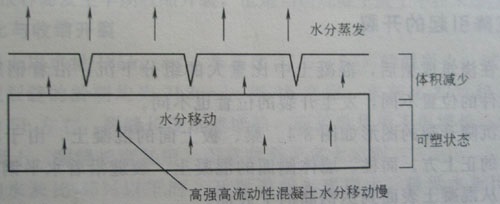
Picture-2 occurrence of plastic shrinkage cracking
Plastic shrinkage joints and plastic settlement joints generally appear during the plastic state of concrete (or slurry), and their duration is short, about 1 ~ 2 hours, starting when the luster of concrete surface disappears (the end of bleeding and water collection). The crack trend is irregular, the length varies from a few centimeters to a few meters, the middle is wide, the two ends are thin, and the depth may be limited to the shallow area of the surface. However, when the external temperature is high, the wind speed is high, and the climate is dry, it may run through if no corresponding measures are taken and the crack is allowed to develop. However, through the test, even if the penetration has no effect on the bearing capacity of concrete structures.
Plastic shrinkage joints often occur on the exposed surfaces of floors and floorslabs. The thinner the plate surface is, the easier it is to appear. When the temperature is high, especially when it is dry and strong wind blows, the concrete surface is very easy to evaporate and dehydrate (the bleeding at the bottom is too late to float up for supplement). Therefore, the concrete will form a humidity gradient from the surface to the inside (the internal and external humidity is inconsistent and distributed in a ladder shape). The excessive humidity gradient causes the sharp shrinkage of the concrete surface. At this time, the concrete basically has no tensile capacity, resulting in the first cracking of the concrete surface and the formation of plastic cracks. Without effective curing, plastic cracks will gradually extend to the interior of the concrete with water loss until the whole section runs through.
In the process of concrete setting and hardening, due to self weight, the major components will sink and the water with small specific gravity will rise, that is, bleeding will occur. The result of bleeding will make the concrete structure more compact and reduce the size of the concrete in the height direction (shrinkage). At the junction of beam and slab, the junction of beam and column, and the junction of slab and wall, due to their different dimensions in the height direction, their respective sinking and shrinkage amounts are different, which will lead to large sinking and shrinkage of parts with large height, small sinking and shrinkage of parts with small thickness, and cracks will occur at the junction. See Picture-3.

Picture-3 section of settlement crack
a) Beam slab structure b) foundation slab
After the concrete is poured and formed, the major components in the concrete sink. When restrained by reinforcement, tie rod and embedded parts, settlement cracks occur. Due to settlement cracks, the cracks in the concrete on the beam and slab are directly above the reinforcement, while the cracks in the concrete on the side of column and wall are along the direction of horizontal reinforcement. The cracks are from the concrete surface to the upper surface of reinforcement. See Picture-4.

a) Cracks along the upper surface of the reinforcement b) cracks along the side reinforcement
The water evaporation rate is a measure of the amount of water evaporated in the sand pot per unit area per unit time. Its physical meaning is very clear, that is, if the amount of water evaporated per unit area per unit time exceeds a certain value and the evaporation rate exceeds the rate of bleeding reaching the surface, the concrete is likely to have surface cracks. 1.0kg/m3/h is the critical value of evaporation rate (ACI305R-96), which means that when the water evaporation rate exceeds this value, the concrete will produce surface cracks. In order to prevent plastic cracks, other measures need to be taken to supplement water on the concrete surface and reduce the evaporation rate. For commercial concrete, because it is mixed with superplasticizer and other admixtures, the total amount of bleeding is less than that of conventional concrete. This critical value needs to be reduced to ensure no surface cracks. Generally speaking, 0.6kg/m3/h can be used as the critical value of evaporation rate of commercial concrete.
The calculation of water evaporation of plastic concrete is shown in Picture 1,

The construction unit shall find out the water evaporation from the attached table according to the observation data of the regional meteorological department (the construction unit shall provide its own simple temperature and humidity tester), the maximum external temperature, minimum relative humidity and maximum wind speed on the day of concrete construction. If it exceeds 0.6kg/m3/h, it can be presumed that the possibility of plastic cracking of concrete is very high, and measures must be taken to prevent it. It should be noted that when the water evaporation exceeds the above value, as long as the concrete is poured into the formwork, cracking may occur at any time. It should be prevented from the view that "cracking should occur after the concrete hardens", and technical measures should be taken at any time according to the weather conditions. The values of temperature and humidity in the table should be actually measured according to the specific situation at that time. The wind speed can be judged by the attached table comparison table of wind grade and wind speed. At the same time, pay attention to whether the specific construction location is on the mountain, tuyere or high-rise. There is a large gap between the wind speed at these locations and the ground wind speed, and the predicted wind speed generally refers to the ground wind speed. Check the table to determine the wind speed based on the judged phenomenon.
In the absence of wind, the evaporated water vapor will form a protective layer with high humidity on the concrete surface to reduce cracking to a certain extent. However, in the case of wind, the protective layer will be blown away quickly, exposing the concrete surface directly to high temperature and dry air, resulting in increased water loss. The evaporation of water is directly proportional to the atmospheric temperature and inversely proportional to the relative humidity. Affected by the wind speed, air pressure, sunshine and other factors at that time, the evaporation of water on the surface of concrete components poured in cool summer is multiple times higher than that at normal temperature. For example, the saturated steam pressure of water is 9.21 at 10 ℃, 17.53 at 20 ℃ and 55.32 (mm Hg) at 40 ℃, that is, the saturated steam pressure of water is nearly doubled when the temperature increases by 10 ℃. From the viscosity value related to evaporation, it is 13.10 at 10 ℃, 10.21 at 20 ℃, 8.00 at 30 ℃ and 6.54 (mη) at 40 ℃, That is, when the temperature increases by 10 ℃, the viscosity of water decreases by 20-30%. These two types of values indicate that the higher the temperature, the more water evaporates from the concrete surface. Therefore, in the high temperature season, we should pay more attention to the plastic cracks caused by water evaporation. In comparison, the relative humidity has a greater impact on the plastic shrinkage of concrete. Some data show that when the air temperature and concrete temperature are 32 ℃, the relative humidity is 10%, and the wind speed is 11m / S (about force 6 wind), the water evaporation rate is 50 times that when the air temperature and concrete surface temperature are 21 ℃ and the relative humidity is 70%, which is very easy to produce plastic cracks.
If the concrete temperature is higher than the air temperature (due to the sun exposure or other reasons, such as the concrete cannot be poured into the formwork for a long time after the mixer arrives at the site, and the hydration has begun), even under the saturated condition of cool temperature and 100% relative humidity, the rate of water evaporation from the concrete surface is considerable. Therefore, plastic cracks may appear in the concrete in cool and humid climate.
Due to improper placement of formwork support, especially supporting formwork on the foundation, it is easy to cause pillar sinking and formwork bulging, which not only makes the accuracy of concrete structure poor, but also becomes the cause of concrete cracking. See Picture-5

Picture-5 cracking caused by improper placement of formwork
a) Cracking caused by formwork support subsidence b) subsidence caused by poor bearing capacity at the bottom of formwork support
Due to the poor bearing capacity of the bottom of the formwork support, the support sinks, resulting in the cracking of the upper surface of the beam slab junction. This kind of crack usually occurs at the early stage of formwork hardening. Therefore, when erecting the formwork, we must pay attention to whether the stratum under the pillar is firm and has sufficient bearing capacity. Due to the relaxation of the formwork support system, the concrete causes the formwork to swell, resulting in concrete cracking.

Picture 6 cracking caused by lateral change of formwork Picture 7 cracking of shallow surface of concrete
If the concrete slump is large and vibrates excessively during vibration, there will be a slurry rich layer on the concrete surface. If it is not treated during plastering, shallow cracks will appear. See picture-7
4. Technical measures for crack control
4.1 When the outside temperature is high and the wind is strong, the water evaporates rapidly from the concrete surface during or just after the pouring. Under the action of wind, the water is blown away from the concrete surface by the wind. If it develops further, the concrete will become dry and crack. Therefore, it is hoped to avoid pouring concrete in the daytime with direct sunlight in summer as far as possible (in the case of high temperature and direct sunlight in summer, the concrete sometimes forms a layer of hard skin on the surface. At this time, the interior of the concrete under the surface is still plastic. Due to the operation, the concrete will leave irreversible footprints on the concrete surface, and the surrounding of the footprints will crack due to settlement). When it is impossible to interrupt the pouring, when pouring more than one layer of concrete, use the external scaffold to lay felt cloth, which can prevent the wind and the sun for a period of time. On the upper surface of the floor that can be renovated, after pouring the concrete, lay moisturizing geotextile sacks, straw curtains, grids, etc. to prevent moisture evaporation as far as possible. Picture -8 curing.

Picture-8 tarpaulin shall be used for wind protection during construction Picture-9 external gunny bag shall be used after construction
4.2. Settlement cracks generally occur along the upper surface of horizontal reinforcement, such as along the upper surface of horizontal reinforcement in the upper part of slab and beam, or along the junction of beam and slab. For the cracks along the horizontal reinforcement, the depth of the cracks mostly reaches the reinforcement surface, which will reduce the bonding force and rust in the future. This settlement crack occurs in the process of bleeding. In summer, it is 0.5-1.5h after pouring, 1-2h in spring and autumn and 3-6h in winter. Carefully observe the concrete surface according to different construction periods and the temperature, humidity, wind speed and other conditions in the environment at that time, in case of cracks, secondary vibration treatment shall be carried out in time. If the second vibration time is too early and continues to sink after vibration, cracks will still appear and do not play a corresponding role. If the secondary vibration is too late, it is difficult to vibrate due to the hardening of concrete, and it can not eliminate settlement cracks.
The time of secondary vibration shall be determined according to the reduction of bleeding water. When the bleeding water on the concrete surface is basically completed and the brightness of surface water is basically eliminated, secondary vibration can be arranged. At this time, press the concrete surface with hands and there shall be traces.
4.3 Control loading time
Article 7.4.1 of code for acceptance of construction quality of concrete structures (GB50204-2002) stipulates that "before the concrete strength reaches 1.2MPa, it is not allowed to step on and install formwork and supports". The ready mixed concrete adopts retarding technology. Generally, the initial setting time is controlled at 6-8h, the mass concrete is 10-12h, and it may even reach more than 16h if there are special requirements. The interval between initial setting and final setting of concrete is short, at about 1-2h, the concrete strength begins to increase after final setting, and it takes a certain time to reach 1.2MPa. This time is different due to the difference of concrete strength grade and environmental conditions (mainly air temperature). For the sake of safety, when the daily average temperature is above 25 ℃, it is 12-16h, and when it is lower than 25 ℃, it is generally 24 hours after pouring.
After the final setting, people can work (they can't step on the footprints just after pouring), or lift materials to the working face. The weight of personnel and materials is transferred to the formwork through the concrete that needs formwork support itself, which not only stirs the poured concrete, but also the formwork and formwork support, especially the formwork support of the slab, under the concentrated, uneven and excessive construction load, the concrete will deflect due to insufficient stiffness, In particular, the concentrated impact load generated when lifting materials will make the formwork with insufficient stiffness vibrate. Even slight vibration will have a serious impact on the concrete before and after initial setting, causing cracks visible to the naked eye and small cracks invisible to the naked eye, causing damage to the structure.
At. The same time, article 4.2.1 of the code for construction acceptance (GB50204-2002) stipulates: "when installing the upper formwork and its support of cast-in-situ structure, the lower floor shall have the bearing capacity to bear the upper load or add support, and the columns of the upper and lower supports shall be aligned and laid with base plates. Article 4.3.5 stipulates that" when the formwork is removed, there shall be no impact load on the floor, and the formwork and support should be stacked separately and transported in time. " If the operation is not carried out according to the above provisions, it will lead to cracks as shown in Picture-10. Such cracks have the characteristics of wide cracks at the bottom of the plate, diverging outward from one point, small cracks on the plate surface when penetrating or not penetrating, but wet marks or water droplets are found at the bottom of the plate when watering on the plate surface. Such cracks caused by improper construction load may further develop when the structure enters the service stage, or cause obvious functional defects, in serious cases, it will reduce the bearing capacity of the structure and affect the use safety and durability of the structure, which should be strictly prevented.
Picture-10 floor slab bottom crack caused by construction load
4.4 Secondary vibration and moisture curing during beam and slab structure pouring:
The beam slab structure has a large surface area, easy evaporation of water, easy loss of hydration and low temperature rise. Therefore, the loss of water and insufficient secondary vibration, compaction and troweling are important factors leading to the early cracks of beam slab structure. With the growth of concrete age and the change of environment, it will aggravate the expansion of early cracks and may become harmful through cracks. The following figure shows the effect of secondary vibration and compaction on the effective control of crack propagation, and the effect of secondary vibration and compaction on crack propagation is also shown in picture-11 and picture-12.
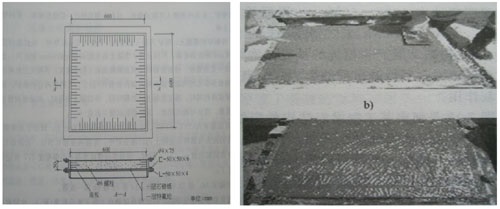
Picture-11 concrete crack resistance test by flat plate test method
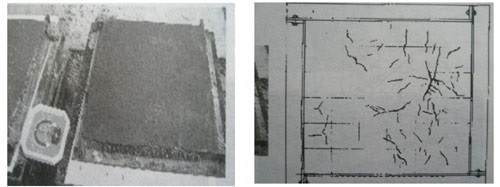
Picture-12 cracks of concrete specimens under different moisturizing conditions
Left: specimens under different moisturizing conditions in the same environment; Right figure: crack development of uncovered specimen (measured description)
The concrete for the test is prepared according to the initial setting of 8h, the initial slump / expansion = 245 / 650mm, there is no separation, bleeding and hardening, and the specimen with good workability and tightly covered with plastic film after molding has plasticity after 4h, and there are no visible cracks. Plastic shrinkage cracks begin to appear after the exposed test piece is put into the mold for 1.5h. When the concrete is put into the mold for 2h, the left half of the test piece is compacted and pressed to close the cracks. Some cracks on the right half that are not pressed and plastered continue to develop and increase, grow longer and wider (≈ 1.5mm), and then fine cracks appear on the pressed and plastered half. The thermometer and hygrometer in the middle shows that the temperature is 32-39 ℃ and the humidity is 40-60% during the 4H test since the concrete is put into the mold. After one week's inspection, the maximum crack width on the half plate of secondary plastering is 0.3 mm and the total length is 220 mm, the maximum width on the half plate of non secondary plastering is 1.5 mm and the total length is 1850 mm, and there is no crack on the plate covered by plastic film.
4.5 Strengthen plastering:
Plastering can effectively reduce the cracks on the concrete surface. When the bleeding of the concrete surface is over and the initial setting of the concrete is about to begin, the concrete surface shall be roughened and plastered in time, which can effectively prevent the formation of humidity gradient, bridge the formed cracks and reduce the cracks on the concrete surface after final setting. Timing of final plastering: before the initial setting, the bleeding of concrete ends, and there are shallow marks. After plastering, pay attention to whether there are small cracks on the surface, and rub it selectively in time before final setting.
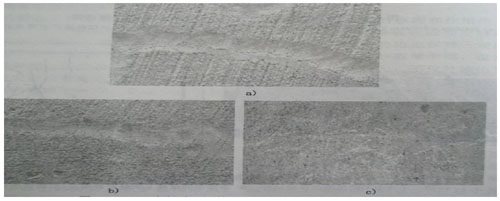
a) Cracks with ineffective secondary plastering (vibration); b) C) secondary plastering (vibration) eliminates and reduces cracks
After the ready mixed concrete is poured into the formwork, the time for final plastering is short, and the concrete surface of large area often needs plastering. It is necessary to arrange enough personnel to plaster the concrete in time to prevent local failure to plaster in time due to untimely plastering and pressing, resulting in more cracks on the concrete surface.
As shown in picture-13, the cracks in the beam and slab structure of a construction site were dry and windy at that time. It was not covered in time after pouring, and the concrete surface lost water and cracked rapidly. At that time, the concrete did not initially set, but the crack could not be closed by pressing and plastering. The operator tried to close the crack by knocking with a wooden hammer. There were three situations shown in the figure. It can be seen that early plastic cracks can be avoided when they are found in time and handled properly.
4.6 Curing: curing is the most effective measure for the normal growth of concrete strength and the prevention of cracks in concrete. We must pay full attention to it, formulate a curing scheme, and assign special personnel to be responsible for the curing work.
After the completion of concrete pouring, the concrete structure shall be kept at sufficient temperature and humidity in time, so as to ensure the formation and growth of various expected properties of concrete in the later stage. When the natural conditions around the structure cannot meet the temperature and humidity required for curing, it is necessary to artificially create corresponding temperature and humidity conditions, that is, create reasonable temperature and humidity, try to avoid rapid drying, rapid temperature change, vibration and disturbance of external forces, and ensure the normal development of various indicators of concrete.
The normal development of various indexes of concrete requires reasonable humidity. Reasonable humidity refers to that certain water will be reserved for curing during pouring, but due to the dry environment around the structure, the water contained in the concrete other than hydration will be evaporated and escaped, resulting in insufficient water required for concrete curing, and slowing down or even interrupting the later performance development of concrete. Therefore, it is very necessary to add water to the outside of the structure.
The normal development of various indexes of concrete requires a reasonable temperature. Reasonable temperature means that the hydration rate of cement increases with the increase of temperature. Under the condition of < 10 ℃, the hydration rate is slow. Under the condition of 0 ℃ and negative temperature, the hydration rate almost stops without progress. In terms of later strength, curing at lower temperature is more favorable than curing at higher temperature. The temperature of early hydration of concrete depends on the ambient temperature, solar irradiation temperature, the heat released by cement hydration and the original temperature of sand and gravel materials. The reduction of evaporation and watering on the concrete construction surface will significantly reduce the temperature and be conducive to the growth of later strength. In the curing process, especially for mass concrete, it is appropriate to cure a low reasonable temperature, that is, the temperature should not be too high.
The principle of curing is to cure the reasonable moisture and temperature of the poured concrete. In order to enable the concrete to be hydrated and hardened normally, curing shall be carried out within a certain time after the concrete is formed, so that the surrounding environment has a certain temperature and humidity, so as to ensure the strength and durability of the concrete.
Natural curing is a common curing method in cast-in-situ concrete engineering at present. It refers to the curing of concrete in a certain humid environment without taking too many measures when natural conditions permit. However, when the external environment changes, natural curing is prone to cracks, and the control effect of early cracks is very poor. In the season prone to early cracks, natural curing shall not be used instead of normal curing.
In addition to natural curing, common curing methods include storing water, spraying, sprinkling water on the surface of concrete structures, spraying water vapor or water saturated blankets, cotton blankets, sand, sawdust, straw covering water, or covering paper, plastic film or waterproofing coating on the surface of concrete structures to prevent evaporation of water.
Water storage is a thoughtful way to cure the level surface, including using soil or sand to cure a layer of moisture on the surface. When the water is adequate and the drainage is not a problem, the use of spray (hose) is also a good way to keep the concrete moist. This method can be used on both vertical and horizontal surfaces. The ideal spray should be continuous, but if it is interrupted, we should carefully check whether the two spray gap concrete is too dry. Spray pressure should not be too large, otherwise the concrete surface will be washed away.
Mulching is another method of water conservation. It can not only retain a large amount of water, but also prevent water evaporation. Sacks and other absorbent materials are widely used in covering and moisturizing, and they are suitable for both horizontal and vertical. Sometimes, wet soil, sand, straw bags, grass fences and sawdust can also be used as good measures on the horizontal surface. In winter, these materials can cover the concrete surface after pouring and also play the role of thermal insulation layer. However, the moisturizing layer after surface coverage needs to be watered regularly. Because they are easy to dry, and they should be pre wetted when they are first laid on the concrete surface to prevent them from absorbing water from the concrete surface and causing water shortage in the concrete. Plastic film is also a good heat preservation and moisturizing material. Without requiring a smooth surface, the surface is covered with plastic film immediately after pouring, which can not only prevent water evaporation, but also moisturize the concrete. At the same time, films of different colors also play a good role in concrete thermal insulation and preventing sunlight exposure: white films can reflect the heat of sunlight in the high-temperature season in summer and prevent the concrete from heating too high, while black films can still bring more heat to the concrete surface under the weak sunlight in winter, which plays a good role in protecting the concrete in winter.
Wood formwork and bamboo plywood are also a kind of curing materials, which can play a certain role in protecting the structure in the vertical direction, but the water absorption capacity of bamboo plywood is poor, and the protective effect is worse than that of pine and other wood formwork. The specific heat of wood formwork is small. In cold winter, the concrete structure is wrapped with wood formwork (vertical structure without formwork removal) just like putting a layer of clothes on the concrete to prevent the concrete from frostbite or slow rise of strength. However, due to the large water absorption capacity of wood formwork, the formwork must be poured thoroughly with water before concrete pouring, so as to prevent water absorption and dehydration of concrete during pouring.
For the vertical structure with small water cement ratio, in order to prevent the plastic shrinkage cracks on the early surface, the wood formwork needs to be watered and cured regularly. For the bamboo plywood formwork, when it can be demolded, loosen the formwork pull rod to keep the distance between the formwork and the concrete surface within 1cm. At the same time, water the top surface of the vertical structure to make the water wet the concrete surface along the gap. At the same time, The loosened formwork can also prevent the damage of external heat and dry environment to the vertical structure.
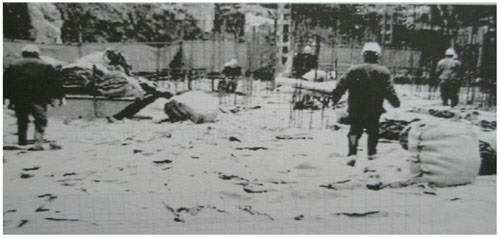
4.7 Time to start curing
No matter which method is adopted, the concrete shall be about 1 hour before the initial setting, that is, the bleeding on the concrete surface is about to evaporate, and the concrete shall be vibrated and plastered twice. At this time, the concrete can still be vibrated strongly, or the concrete can still be flooded under the beating of great force. Although the concrete is not completely set and hardened, it can be cured by people at this time. The water poured on the concrete surface will basically not bring out the cement slurry in the concrete. The starting curing time has a great relationship with the temperature, humidity and wind speed in the environment (see above). In bad weather, pay attention to the concrete surface at any time. If the seeping water disappears completely and there are small shrinkage cracks on the surface, it means that it is time to start curing, the water shall be supplemented immediately, and the parts with small cracks shall be rubbed and patted twice to eliminate the small cracks.
